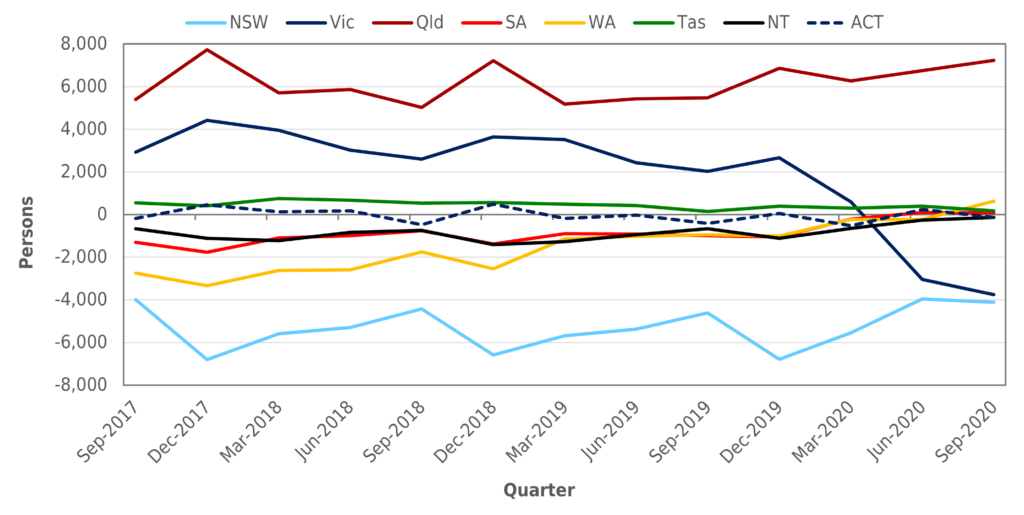With the political demise of Donald Trump, it might have been assumed that the need for walls to divide and separate was on the decline. However, with the onset of the pandemic, Australia has reverted to and continues to behave in its old colonial ways, with each State ‘going it alone’. The move has been highly popular within States, showing that populism and pandemic mitigation are strange bedfellows. The result of the Western Australian election in March proves the point categorically. The policies that have been adopted by State Governments to each other, as well as policies within States towards hotel quarantine and community outbreaks, have created interesting and perhaps unexpected outcomes in terms of population and housing.
Interstate Migration
The patterns of growth and change have been reasonably well-established since the end of the mining investment boom about ten years ago. Victoria and Queensland have been the major net beneficiaries of population. New South Wales, South Australia and the Northern Territory have lost population, while Western Australia has gone from a major net gain to a large loss to relative parity. The ACT and Tasmania tend to gain a small number of people, although the numbers in the former territory depend on local housing market factors, with NSW ‘overspill’ being a major factor in change over time.
At the time of writing, only two quarters of data (ending June and September 2020) are available that include the impact of the pandemic. The September data is provisional. The data from the ABS suggests that the flows have altered considerably in some jurisdictions in both quarters. See chart below.
Net Interstate migration flows, September 2017 – September 2020

Source: ABS, Regional internal migration estimates, (Cat. No.3412.055.005)
The net gain to Victoria is estimated to have reversed in the June and September quarters, while South Australia is estimated to have gained from interstate migration for the first time in more than 15 years. A drop in the net interstate migration loss from NSW was also estimated for both quarters, while WA registered its first net quarterly gain through interstate migration for 7 years in September.
These changes to migration flows are a little unexpected. After all, Victoria did not go into hard lockdown until the September quarter of 2020, but saw a big change in the June quarter. Of course, after the first lockdown in Melbourne, some people may have exited Victoria and others may not have wanted to move to Victoria with the greater levels of restrictions in their day-to-day lives.
So, are these data just an aberration, a methodological issue, the effect of border closures or a significant rebalance in the economic situation of the states? In this most extraordinary year, it is hard to say definitively. However, it is likely that the rollout of the vaccine should ‘equalise’ the playing field again with borders open once more. However, the impact of the pandemic may be more severe in some States and Territories than others.
A look at unemployment rates suggests that the pandemic affected Victoria, Tasmania and New South Wales most obviously. Comparing the increase in unemployment rates in the December quarters for 2019 and 2020, Victoria increased by 2.1%, Tasmania by 1.8% and NSW by 1.7%. Curiously, the changes in Victoria were greatest in the March and June quarters, suggesting a negative change to Victoria’s economic fortunes before the onset of the pandemic. Furthermore, Victoria did not register a meaningful drop in unemployment rates in the December quarter like many of the other jurisdictions. See chart below.
Unemployment rates, March 2019 – December 2020

Source: ABS, Labour Force Australia (Cat. No.6202)
The increase in unemployment rates in NSW was greatest in the June quarter, which is consistent with general levels of economic uncertainty at the time and the collapse of the tourism area of the Australian economy. The importance of tourism to Tasmania is indicated by the continued rise in unemployment rates from March 2020 onwards, a situation that was probably reinforced by the strict border closure policies. Given the more open border policies during 2021, this rate should start to decrease.
Although Queensland has one of the higher State and Territory unemployment rates in Australia, the impact of COVID-19 has only resulted in a moderate increase in unemployment rates (1.4%). So, although Queensland is estimated to have the second-highest unemployment rate of the six States and two territories in Australia as of December 2020, it continues to attract people from other States. Beautiful one day, perfect the next, whether you have a job or not. Like Tasmania, Queensland will greatly benefit from opening its borders to tourists.
The next six months of interstate migration estimates will be watched closely. It seems that Victoria will struggle to revert to its pattern of interstate migration gain. Queensland may gain fewer people from interstate migration unless more employment is created. Western Australia looks to be on the cusp of another boom, which will likely attract larger numbers from the eastern States again. South Australia will most likely return to its pattern of loss to other States. New South Wales will probably continue to lose population to other States, but the relativities of the State economies, especially that of Queensland will determine the volume of population flow.
In the next blog article, we will look at the impact of COVID-19 on metro to regional migration.

